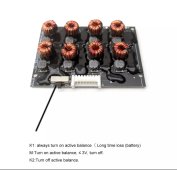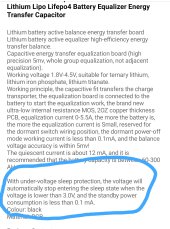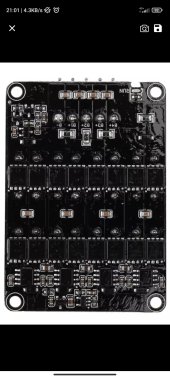You are using an out of date browser. It may not display this or other websites correctly.
You should upgrade or use an alternative browser.
You should upgrade or use an alternative browser.
Active balancer, make it smart!?
- Thread starter Vi s
- Start date
curiouscarbon
Science Penguin
- Joined
- Jun 29, 2020
- Messages
- 3,029
thank you for the video!I have not examined the Heltec capacitor balancer mself but it appears to be similar to a serial-parallel-serial balancer. I have not had much interest in it as I would not trust 6.3v rated electrolytic caps reliability, subjected to potentially high ripple currents to expensive battery cells.
Because of the series resistances involved in MOSFET's and capacitors it will likely do more to misbalance cells when all cells are below 3.4v.
This video has an explanation.
they claim that the heltec capacitive active balancer operates with the following mode:
there's a capacitor for each cell. first, Cell 1 charges Capacitor 1, Cell 2 charges Capacitor 2, etc..
then all the capacitors are disconnected from cells, then connected to each other in parallel. this equalizes the voltages of the capacitors.
then the capacitors are disconnected from each other, and reconnected to the cells.
by virtue of parallel balancing the capacitors, the cells will also be "virtual parallel balanced" in a switching manner.
unsure how bad the ripple situation is.
it makes a lot of sense to me. thanks again for the video.
active balancing is definitely a useful ability
one lingering curiosity... there are quite a few capacitors (read: more capacitors than cells). i wonder if they are being used parallel to reduce load on each one, or being used as a baton pass type thing..
curiouscarbon
Science Penguin
- Joined
- Jun 29, 2020
- Messages
- 3,029
may i ask more about the situation where you expect maximum ripple current?not trust 6.3v rated electrolytic caps reliability, subjected to potentially high ripple currents to expensive battery cells.
e.g. battery is serving a single phase inverter, has current ripple, leading to damage of balancer?
6.3V is much higher than the 3.65V maximum i expect from a single LFP cell.
but if even two cells were series connected to a single cap, of course that could easily exceed the rating.
according to the video, the capacitors are connected to a single cell, disconnected, then parallel connected with all other capacitors.
if the circuit is designed properly, it should be electrically impossible to apply more than a single cell voltage to a given capacitor?
perhaps in a potential "shoot through" condition where the cells are connected to the capacitors at the same time as the capacitors are being parallel balanced?
thanks again for all that you share.
That is exactly what my unit is doing without an external microcontroller. The VOUT terminals that are connected to the 'RUN' pads of the balancer are closed at 54.4 V and opens at 53.6V (my battery pack is LifePo4 16S1P). These trigger points are set using the M609 pushbuttons. The modification isolates the VOUT terminals from the rest of the M609 circuit. The added 48V relay disables the M609 if there is no solar power.I just have a simple voltage sense circuit controlling a relay which is connected to the RUN tabs. At 27 V it turns balance on and at 26.8 V it turns off. When I get around to tidying things up I'll try and use the R PI to control the Heltec's.
I suppose this would be a fitting module for the purpose of simply opening and closing the RUN bridge without having to do any mods on the module nor active balancer!
Xh-m601
Pro: super low self consumption at 0.3ma!
(There are also other similar modules like xh-m602 with display and buttons for almost the same price but consume 20 to 50ma, about 0.2 to 0.5W)
Con: difficult to adjust lvd etc
How to adjust
Has someone experience with this module?
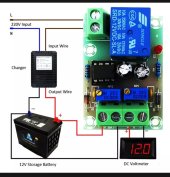
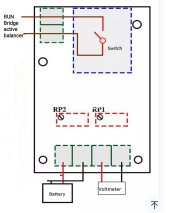
Xh-m601
Pro: super low self consumption at 0.3ma!
(There are also other similar modules like xh-m602 with display and buttons for almost the same price but consume 20 to 50ma, about 0.2 to 0.5W)
Con: difficult to adjust lvd etc
How to adjust
Has someone experience with this module?


Last edited:
Secondary relay is there to just open or close the RUN connection without inducing any energy/ without potential energy behind/ without connection to the battery. Maybe i got it wrong but if you would directly connect the load outputs you would cause a short.
Open and closing a jumper should have minimal/zero current through it.
As for only having the active balancer running when SCC is pumping into the cells. IMO id much rather have the active balancer running based on a voltage set point ie system voltage is higher than a certain point that means the SCC is on.
Soon as the SCC is off voltage will bleed down, this added time of active balancing while cell voltages drop will only help balance the cells.
Finding that set point where active balancer isn’t running too long will be key. Don’t want it running too long nor too short.
Last edited:
For me personally key won't be whether there is solar energy or not nor how long or short it balances but the voltage range in which it operates. I intend to have it switch on at about 3.43V cell average and switch off again at about 3.4V if possible. Once the pack is balanced the balancer doesn't work anyway anymore and their quiescent currents are pretty low so time is no issue for me. usually my active balancer gets my pack into balance again within 2-10min. It works really fast!Open and closing a jumper should have minimal/zero current through it.
As for only having the active balancer running when SCC is pumping into the cells. IMO id much rather have the active balancer running based on a voltage set point ie system voltage is higher than a certain point that means the SCC is on.
Soon as the SCC is off voltage will bleed down, this added time of active balancing while cell voltages drop will only help balance the cells.
Finding that set point where active balancer isn’t running too long will be key. Don’t want it running too long nor too short.
I have to play around a bit to find the sweet on-off voltage spots for my battery pack and usage. I just ordered a xh-m601 and now starts the waiting game again. Pretty cheap, 0.81usd inclusive shipping. Hope it works reliable enough. Will later post my experience with it if there is interest.
I did let my balancer running for months and it totally unbalanced my whole pack. The difference between my cells was 20 to 40% capacity. Since i am using daily high currents my cells (will have to check their contacts again) get easily out of balance so having an active balancer really speeds things up (BMS balancer is ultra slow). So i hope the xh-m601 will prevent any issues and automatice balancing.
Last edited:
You just need to be above knee. Below this the voltage is flat so balancing seems pretty useless to me.For me personally key won't be whether there is solar energy or not nor how long or short it balances but the voltage range in which it operates. I intend to have it switch on at about 3.43V cell average and switch off again at about 3.4V if possible. Once the pack is balanced the balancer doesn't work anyway anymore and their quiescent currents are pretty low so time is no issue for me. usually my active balancer gets my pack into balance again within 2-10min. It works really fast!
I have to play around a bit to find the sweet on-off voltage spots for my battery pack and usage. I just ordered a xh-m601 and now starts the waiting game again. Pretty cheap, 0.81usd inclusive shipping. Hope it works reliable enough. 0
I agree in general but why i start a bit earlier is because I usually have a runner cell. So i want to slow down that cell early on. Further since this is only cell average there will be a cell which is even far higher than 3.43V once the balancer kicks in. I probably have to start even lower. Let's test and find out once it arrives.You just need to be above knee. Below this the voltage is flat so balancing seems pretty useless to me.
A jk BMS would really be the best because it manages the cells individually but the new 4s version is overkill for my 53ah pack and still too pricey for me. I wait for a cheaper, lower current version. But maybe the xh-m601 will already do the tasks i am looking for well enough!?
I really wonder why no active balancer manufacturer hasn't yet integrated an adjustable or even fixed balance cell voltage start and stop yet!? They should know that leaving that thing on permanently disbalances the pack. They could even do it so that each cell starts stops separately at about 3.45v or so. Shouldn't be that complicated to do. They already have a limiter so they just would have to set the low point higher. their high point 3.6v is already good enough.
Or maybe there is a smart knowledgeable person here who can figure out which resistor has to be replaced to increase the limiter voltage point when the balancer stops working. So we could do a diy mod!
Or maybe there is a smart knowledgeable person here who can figure out which resistor has to be replaced to increase the limiter voltage point when the balancer stops working. So we could do a diy mod!
GOOD NEWS
Today i contacted Hankzor if they possibly could customize one of their active balancers to switch OFF at 3.4V instead of 3.0V like the stock version.
Eventually the kind customer agent promised to talk to the factory to customize one active balancer first for an small extra charge. He promised he will come back to me again once the customisation is done. After that i am going order it and post my observations after testing here. If it works like the stock version and on top stops balancing any cell which goes below 3.4V, that itself would be already a huge improvement. Guess i will have to test this one properly, maybe i even record it for you.
So stay tuned, maybe there will be soon an affordable active balancer available which doesn't cause imbalance anymore!
Today i contacted Hankzor if they possibly could customize one of their active balancers to switch OFF at 3.4V instead of 3.0V like the stock version.
Eventually the kind customer agent promised to talk to the factory to customize one active balancer first for an small extra charge. He promised he will come back to me again once the customisation is done. After that i am going order it and post my observations after testing here. If it works like the stock version and on top stops balancing any cell which goes below 3.4V, that itself would be already a huge improvement. Guess i will have to test this one properly, maybe i even record it for you.
So stay tuned, maybe there will be soon an affordable active balancer available which doesn't cause imbalance anymore!
Last edited:
Hankzor agreed to customize following 4s active balancer first.
IMO these capacitive balancers work the best of all these cheaper active balancers (i have a few models). I am using them for my 4s and 16s battery since more than a year. They reduce the top balancing time by a lot and work flawlessly so far. Of course they create an absolute mess if you let them stay connected all the time. The improved version would be very welcomed since then i don't have to switch them on and off all the time.
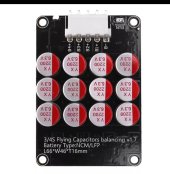
If it works well i plan to also order the 16s version of it.
IMO these capacitive balancers work the best of all these cheaper active balancers (i have a few models). I am using them for my 4s and 16s battery since more than a year. They reduce the top balancing time by a lot and work flawlessly so far. Of course they create an absolute mess if you let them stay connected all the time. The improved version would be very welcomed since then i don't have to switch them on and off all the time.

If it works well i plan to also order the 16s version of it.
Last edited:
Sure will do.Sounds like a good set up, let us know when it ships
Let's see how fast and good they will be.
Hans Kroeger
New Member
- Joined
- Dec 30, 2020
- Messages
- 128
HI there, I have designed such a circuit, that enables active balancing if one of 4 cells exceeds 3.37 Volts. It terminates active balancing if all cells go below 3.34 Volts. More than 50 units have been sold,...... zero complaints till now.I really wonder why no active balancer manufacturer hasn't yet integrated an adjustable or even fixed balance cell voltage start and stop yet!? They should know that leaving that thing on permanently disbalances the pack. They could even do it so that each cell starts stops separately at about 3.45v or so. Shouldn't be that complicated to do. They already have a limiter so they just would have to set the low point higher. their high point 3.6v is already good enough.
Or maybe there is a smart knowledgeable person here who can figure out which resistor has to be replaced to increase the limiter voltage point when the balancer stops working. So we could do a diy mod!

Faktor Shop | KISS activ smart 36/48V
KISS LiFePo4 Smart active Batteriesystem - KISS activ smart 36/48V. Faktor Shop
In particular I have designed various circuits to interface the "run" terminals of the Heltec Balancers.
Next week, when I am back from my vacation, I can post some of those circuit diagrams.
Cheers Hans
Hi Hans,HI there, I have designed such a circuit, that enables active balancing if one of 4 cells exceeds 3.37 Volts. It terminates active balancing if all cells go below 3.34 Volts. More than 50 units have been sold,...... zero complaints till now.
I have played around with the a.m. 12 V and 24 V Heltec Balancers.
Faktor Shop | KISS activ smart 36/48V
KISS LiFePo4 Smart active Batteriesystem - KISS activ smart 36/48V. Faktor Shopfaktor.de
In particular I have designed various circuits to interface the "run" terminals of the Heltec Balancers.
Next week, when I am back from my vacation, I can post some of those circuit diagrams.
Cheers Hans
Wow looks like some high grade "made in Germany" electronics on that website! Always happy to hear about useful innovations, improvements, mods and good ideas!
That would be super lovely of you if you could do so, maybe there are some (hopefully i will be one of them) who will be able to follow your diagrams and can make their heltec balancers smarter and improve their convenience because of your kind knowledge gift!
I love tinkering so i am super looking forward to those diagrams, what ingenious ideas and creations you came up with.
Hans Kroeger
New Member
- Joined
- Dec 30, 2020
- Messages
- 128
Just saw you faced the same issue already a year back and also shared some mods and solutions.
View attachment 96229
View attachment 96230
Good catch. I learned in the meantime, that 3.37 V is the "magic" number for the LFP cell to turn on the active Balancer. Reason: Even for the lowest possible charging current, 3.37 V indicates a full cell with SOC = 100%. I played around with low and high charging currents (I = 0.5 C) and recorded cell voltages during full charge / discharge cycles. I ended up with 3.37 V balancer On, and 3.34 V balancer Off being a good match.
My KISS System produces a maximum balancing current of 4 A. The current is proportional to the voltage difference of the cells (same is true for the Heltec 5 A balancer). Due to the fact, that the balancing current becomes zero, once all cells are balanced, one can be sure, that the balancer reads actual cell voltages not being affected by a voltage drop at the balancer wires!
As promised I will get you some circuit diagrams next week.
Regards Hans
Similar threads
- Replies
- 4
- Views
- 419
- Replies
- 13
- Views
- 805
- Replies
- 6
- Views
- 416
- Replies
- 1
- Views
- 250
- Replies
- 4
- Views
- 631



